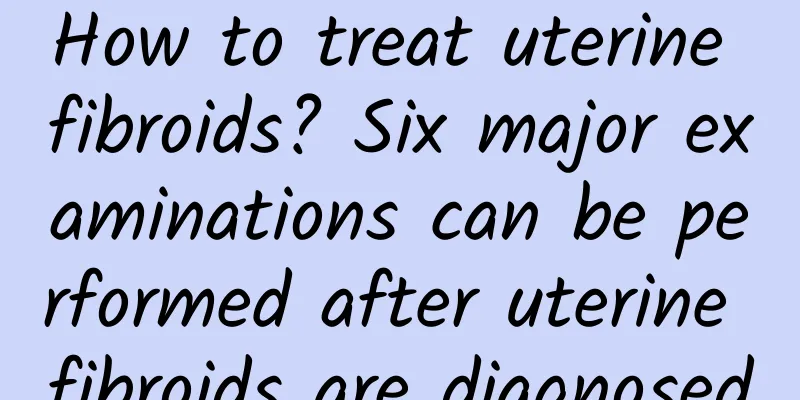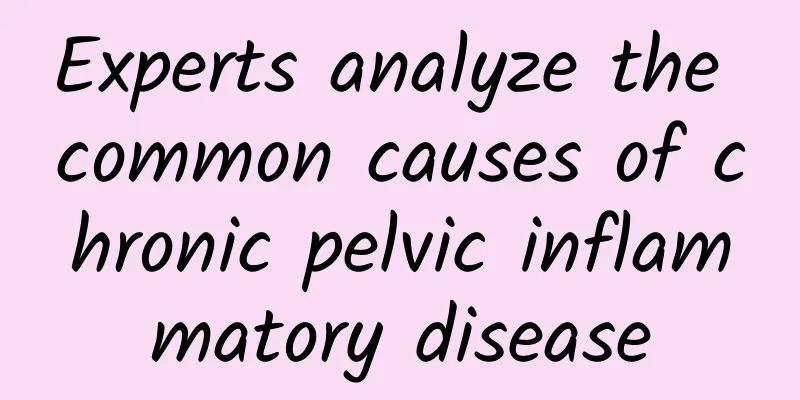How to treat uterine fibroids? Six major examinations can be performed after uterine fibroids are diagnosed

|
Uterine fibroids are a common disease in women, but their cause is still unclear. According to a large number of clinical observations and experimental results, fibroids are a type of tumor that depends on estrogen for growth. For example, it is common in women of childbearing age, 30 to 50 years old, especially in high-estrogen environments such as pregnancy and exogenous high estrogen, and fibroids gradually decrease after menopause. What is the treatment for uterine fibroids? How to treat uterine fibroids? Uterine fibroids are a common gynecological disease that has a more serious impact on women's lives and work, but if not treated early, some patients with uterine fibroids may transform into malignant tumors. The most taboo in treating uterine fibroids is "delaying" From the perspective of tissue development, uterine fibroid cells originate from smooth muscle cells of the uterine muscle and vascular wall, such as immature myoblasts, but the latter have no clear concept in histology. The occurrence of human uterine fibroids may come from the differentiation process of undifferentiated mesenchymal cells to smooth muscle cells. Multiple uterine fibroids may be due to the origin cells lurking in the myometrium. After entering sexual maturity, the undifferentiated mesenchymal cells and mature smooth muscle cells remaining in the myometrium undergo their own continuous proliferation, differentiation and hypertrophy process under the action of the estrogen and progesterone cycle, which is repeated for a long time and eventually forms a tumor. Traditional Chinese medicine has no way to treat uterine fibroids. Using sex hormone drugs to forcibly lower estrogen levels and relieve the symptoms of uterine fibroids is incurable and has serious side effects. Myomectomy or hysterectomy is effective quickly, but if the root cause of endocrine disorders cannot be changed, uterine fibroids may also recur. The most important thing for uterine fibroids is timely detection and early surgery. Choose the appropriate treatment form based on the different characteristics of the fibroids and the patient's own situation. Psychology of patients with uterine fibroids: When a patient is diagnosed with uterine fibroids, the doctor says he must undergo surgery or remove the uterus. The vast majority of patients think "I'll just have to endure it if I can". Many women are reluctant to undergo surgery or have their uterus removed because of uterine fibroids. She thinks that if she removes her uterus, she will not be considered a complete woman. This idea is correct. We must insist on preserving the uterus and find a hospital that can preserve the uterus for surgery. No matter where the fibroid grows, how big the fibroid is, how many fibroids there are, whether there is a fertility requirement, we do not open the abdomen, do not give blood transfusions, do not remove the uterus, do not recur, and maximize the integrity of female anatomy and physiology. There is such a commitment system because we have first-class hysteroscopy experts, the most advanced electronic hysteroscopy, three-chip hysteroscopy and manual laparoscopy equipment; blood recovery machine, intraoperative bleeding can be transfused back into the body after meridian treatment; in addition, we have intracavitary color Doppler ultrasound probes, which can help doctors perform surgery and not miss fibroids. Yangtze River Hospital uses the most sophisticated instruments, the most sophisticated technology, the most economical price and the most precious health. Patients with uterine fibroids should be examined 1. Ultrasound examination B-ultrasound examination is more common in China. The accuracy of identifying fibroids can reach 93.1%. It can show the enlargement of the uterus, irregular shape, the number, location, size of fibroids, whether the fibroids are uniform or liquefied cysts, and whether other organs are compressed around them. 2. Detection of the uterine cavity Measuring the uterine cavity with a probe, intramural fibroids or submucosal fibroids tend to increase and deform the uterine cavity. Therefore, the uterine probe can be used to detect the size and direction of the uterine cavity. Compared with the double clinic, it is helpful to determine the nature of the mass and understand whether there is a mass in the cavity and its location. However, it must be noted that the uterine cavity is often curved or blocked by submucosal fibroids, making it impossible to fully probe the probe, or subserosal fibroids. The uterine cavity usually does not increase, but it can lead to misdiagnosis. 3. X-ray film When the tumor calcifies, it appears as scattered consistent spots, or a shell-like calcified capsule, or a honeycomb with rough edges and wavy shapes. 4. Diagnostic curettage Small submucosal fibroids or dysfunctional uterine bleeding, endometrial polyps are not easy to be found through bimanual diagnosis, and can be assisted by curettage. If it is a submucosal fibroid, the scraper feels the uterine cavity bulge, starts to slide, or feels something in the uterine cavity sliding. However, the scraper can scratch the surface of the tumor and cause bleeding, infection, necrosis, and even sepsis. Strict aseptic operation and gentle movements should be performed, and the scraper should be sent for pathological examination. If the suspected submucosal fibroid is still unclear, hysterography can be used. 5. Hysterosalpingography Ideal hysterography can not only show the number and size of submucosal fibroids, but also their location. Therefore, it is very helpful for the early diagnosis of submucosal fibroids, and the method is also simple. Photography of the fibroid site shows that the uterine cavity is full and incomplete. 6. CT and MRI These two tests are generally not needed. CT image diagnosis of fibroids only expresses details at a specific level, and the image structure does not overlap. The CT image of benign uterine tumors is enlarged in volume, uniform in structure, and high in density +40 to +60H (normal uterus is +40 to +50H). Introduction to several treatments for uterine fibroids What is the treatment for uterine fibroids? How to treat uterine fibroids? Uterine fibroids are a common gynecological disease that has a serious impact on women's lives and work. Most uterine fibroids are benign tumors, but if not treated early, some uterine fibroid patients may turn into malignant tumors. So, what is the treatment for uterine fibroids? Please tell us: 1. Drug treatment: For patients with heavy menstrual bleeding and uterine enlargement to about 8 weeks of pregnancy, androgen treatment can be used after diagnostic curettage to exclude endometrial cancer. Androgen has the effect of counteracting estrogen, promoting endometrial atrophy, contracting the myometrium and vascular smooth muscle, and reducing bleeding. Methyltestosterone and testosterone propionate are commonly used, but the dosage and method should be under the guidance of the doctor to avoid improper medication, causing endocrine disorders, virilization, etc. 2. Surgical treatment: If long-term conservative treatment is ineffective, or if symptoms are obvious, the fibroids are large, anemia and growing rapidly, treatment should be considered. 1) Myomectomy: Suitable for young patients who want to have children. Whether it is subserosal, intramural, or even submucosal, fibroids can be removed through the abdomen to preserve the uterus. Hysteroscopic minimally invasive myomectomy can be used for resection. 2) Hysterectomy: For older patients with uterine fibroids who have obvious symptoms and no desire to continue to have children, total hysterectomy, subtotal hysterectomy, and vaginal hysterectomy should be performed. At around 50 years old, one normal ovary can be retained to maintain its endocrine function. Experts give a detailed introduction to the treatment methods for uterine fibroids. Experts recommend that once women are diagnosed with uterine fibroids, they should communicate with their doctors as soon as possible and determine the best treatment plan as soon as possible. |
<<: How to treat uterine fibroids? What are the hazards of uterine fibroids?
>>: Will uterine fibroid surgery involve hysterectomy? What are the sequelae of hysterectomy?
Recommend
What factors cause vulvar leukoplakia?
Medically, the whitening, roughening, and shrinki...
How much does minimally invasive surgery for pelvic inflammatory disease cost?
How much does minimally invasive surgery for pelv...
Pay attention to the surgical treatment of pelvic inflammatory disease
Understanding the treatment methods for pelvic in...
A good partner for the ketogenic diet ~ 3 tips for eating avocados and 5 major health benefits
In the past two years, the "ketogenic diet&q...
Experts briefly analyze effective treatment methods for adnexitis
As people pay more attention to the treatment of ...
Can you eat salted chicken while losing weight? Nutritionists teach you how to eat without getting fat
For those who want to lose weight by eating out f...
Is counting calories to lose weight a trap? Nutritionist Zhao Hanying reveals: Top 10 detox products to get an S-shaped curve
If you rely on counting calories to lose weight, ...
How to treat chronic cervicitis in women? Pay attention to these matters when treating chronic cervicitis
Chronic cervicitis is a common disease among wome...
The choice of treatment for primary dysmenorrhea requires correct
Dysmenorrhea is divided into primary dysmenorrhea...
How much hcg will rupture in ectopic pregnancy
The rupture of ectopic pregnancy has no direct re...
What are the clinical symptoms of bacterial vaginosis?
What are the symptoms of bacterial vaginosis? Thi...
How to regulate scanty menstruation
To regulate scanty menstruation, you need to adju...
Do you have any of these causes of ovarian cysts?
Ovarian cysts are generally benign tumors, and ov...
Can amenorrhea be passed on to children?
Can amenorrhea be passed on to children? The occu...
Etiology of endometrial tuberculosis
What is the cause of endometrial tuberculosis? En...









